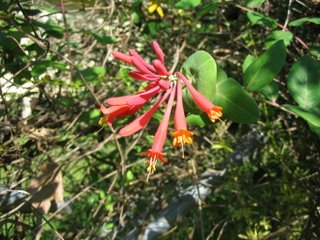FEMA eels

Well, onward. The first female rubythroats showed up day before yesterday. Anticipating the large populations that we have had in the past, some folks have asked to be notified if the hummer banding was going to happen. Dave tells me that he would like to do it, and has tentatively suggested the third or fourth weekend in April. I will get the word out when he can confirm a date. The native honeysuckle is a good way to keep the hummers around; local native-plant nurseries have them.
Many of us become familiar with the bird songs that we commonly hear in our yards. Even apartment dwellers learn 12 to 15 species if they listen around the parking lot, etc, honest. But, just when you think you have them all learned, a sound comes up that is familiar, sort of, but not something you identify with certainty. That happened to me yesterday. There was this thing that sounded like a western quail, a whip-poor-will and a pigeon, or some little piece of each of them. I spent what time I could looking for it visually, but no dice. I consulted references to no avail. Then, this morning I saw what it was. It was an Inca dove. This species has just shown up around the yard for the first time this winter but I had never heard one call. Now I have. It is a mour
 nful two note, up down call that goes on monotonously. But, something new, and a welcome something new at that.
nful two note, up down call that goes on monotonously. But, something new, and a welcome something new at that.The osprey was back yesterday, and again today. It was eating a fish across the river yesterday, so I guess the eagle encounter, if it was the same osprey, didn’t make it leave the territory.
Orchard orioles are back yesterday. Here is another one that you just have to admire. This little oriole sitting on my hummer feeder four feet from me has crossed the whole Gulf of Mexico in the last week – probably in the last three days.
The river is at 11.4 on the Butte La Rose gauge, going to 9.4 by next Wednesday. There isn’t much to back it up on the Ohio or Mississippi. I’m beginning to wonder if this will be a “no crawfish” season for us, again. If our governor was named Marie Antoinette, faced with enraged commoners (us) at the loss of a dietary staple – crawfish – would she have said “let them eat choupique caviar”? And would that have cost her her political life? One may wonder.
Rise and Shine, Jim


0 Comments:
Post a Comment
<< Home